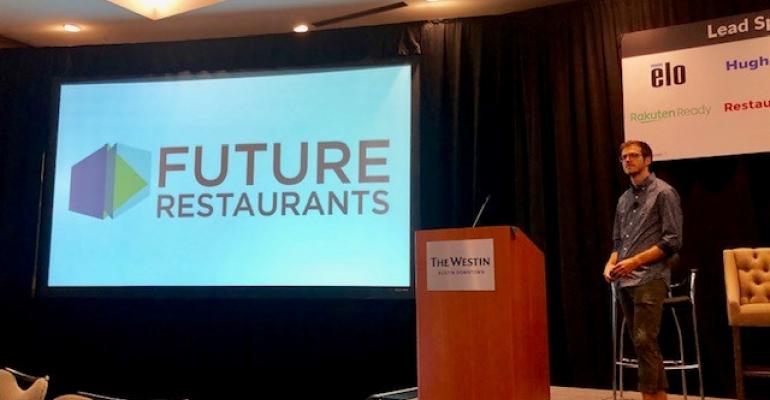More than 120 attendees from top U.S. chains, as well as emerging concepts, gathered at the inaugural Future Restaurants conference held in Austin, Texas this week to learn best practices for coping with a tidal wave of disruptions facing the industry. Among the biggest issue discussed at the event, hosted by New York-based conference operator Worldwide Business Research, was the omnipresence of third-party delivery companies.
Though last-mile operators market themselves as restaurant partners, some chain leaders argued that the four big delivery companies have become rivals as they are starting to act more like restaurants. They own valuable consumer data and offer perks and loyalty programs to keep diners on their apps, leading to mounting third-party commissions.
“They control the carousel,” said Scott Gladstone, vice president of strategy, off-premise and development at Applebee's.
But restaurants are finally fighting back, and third-party delivery operators appear to be listening as both industries strive to meet the growing demands of consumers in a stay-at-home economy. Chains are also making innovation a priority — from changing how they build restaurants to scrapping legacy point-of-sale systems in favor of modern integrated solutions.
“I think the industry as a whole is looking forward — embracing technology and embracing the changing look and feel of a restaurant for the first time I've seen him in a while,” said Zach Goldstein, CEO and founder of customer engagement and marketing platform Thanx.
Goldstein moderated two key panel sessions with leaders of Donatos Pizza, Wahlbergers, Taco Bell, Flyrite Chicken, 5 Napkin Burger, SAJJ Mediterranean and True Food Kitchen. Goldstein, who recently penned a much talked about Medium essay about delivery disruption, said it was refreshing to see an industry conference structured less on menu trends and more on relevant technology needed to fight rising labor costs and capture consumer data.
“Data is a valuable currency that we need to act on especially in a world of third-party delivery,” Goldstein said.
Throughout the fast-paced two-day conference, leaders talked about what keeps them up at night: labor retention; legacy point-of sale systems headaches and delivery integration; and making delivery profitable.
Some offered solutions such as adopting more automation. Here’s what brand leaders had to say.
Delivery: Coping with fees and consumer data ownership
Online food delivery sales are expected to grow from $25 billion to $62 billion in 2022, according to a 2018 report by equity research firm William Blair.
Restaurant digital orders are projected to triple in volume by the end of 2020, according to The NPD Group.
As such, off-premise orders have become the largest area of growth for restaurants as more consumers trade dine-in visits for mobile order and pickup or delivery.
But operators at the conference clearly expressed a love-hate relationship with the delivery revolution. While companies enjoy the top-line growth associated with third-party delivery, most agreed they’re hardly making any money from it.
“It’s a massive hit to the profits,” said Kevin Myers, chief marketing and information officer at Ohio-based Donatos.
Dan Wheeler, who left Dunkin’ Brands for Wahlburgers this summer, said third party delivery companies act as both partners and competitors because they own consumer data.
Still, brands need to embrace delivery because it is “where the consumer is going,” said Wheeler, senior vice president of marketing and innovation at Wahlburgers. “We know that we need to be in that business.”
Other operators say they’re finding it easier to negotiate lower fees amid a heated battle for market share between the top four delivery players, DoorDash, Grubhub, Postmates and Uber Eats.
Applebee’s, for example, is working with both DoorDash and Grubhub. The partnership with DoorDash includes direct delivery through the chain’s website or app. DoorDash is fulfilling the last-mile delivery for a smaller fee because the order is generated directly from the restaurant; DoorDash is also sharing customer data with Applebee’s – something third party operators must do more to remain competitive, said Gladstone of Applebee’s.
The largely franchised Applebee’s, whose parent is Glendale-based Dine Brands, is also passing off service fees to guests to offset margin-hurting fees.
Ultimately, he said Applebee’s is trying to ensure that the cost associated with delivery is “not a race to the bottom.”
A few operators said delivery is not for every brand.
In 2017, Del Frisco’s Grille tested delivery briefly before scrapping the idea.
Brand president Brandon Coleman said the experience of dining on a premium $60 steak doesn’t translate well in a to-go box.
“We’re abstaining,” he said. “The negative outweighed the positive. There’s no sommelier in delivery.”
Labor: High touch vs. high tech
Brands said labor is a huge challenge and many are looking at automation to supplement front and back of the house operations such as pay-at-the table options for full-service restaurants and kiosks for limited-service brands.
 Others are looking at casting a wider net when it comes to hiring.
Others are looking at casting a wider net when it comes to hiring.
Jeff Carper (left), chief operating officer at White Castle, said dealing with wages is the No. 1 issue for the 370-unit quick-service chain.
He said the family-run chain looks at what competitors are paying in each market, and “deal with wages that way” – market by market. Still, it’s a slippery slope when trying to balance wages for employees while also managing menu prices.
“We’re in one of the toughest challenges in my career,” Carper said.
One idea the brand is exploring: robot fryers.
“If any of you have a fryer line, it’s a beast,” he told attendees during a keynote speech. “Can a robot come in and manage that?”
Robotics, he emphasized, would only be deployed for tedious tasks, and will never fully replace labor.
“It will allow us to reallocate labor,” he said.
Wao Bao, on the other hand, believes automation is the future of restaurants.
President Geoff Alexander said the emerging 11-unit brand uses self-serve kiosks and animated cubbies to provide diners a start-to-finish digital experience. The fully automated front of the house system reduces labor costs, while improving order accuracy, he said.
By having lower staffing needs than traditional fast casual restaurants, Alexander said the Chicago-based company, created by Lettuce Entertain You Enterprises, is perfectly “set up for [future] growth and ease of execution.”
Another perk: kiosks allow the brand to capture customer data, which is crucial in an economy driven by personalized digital marketing.
At Taziki’s Mediterranean Café, CEO Dan Simpson said the fast casual chain is embarking on a “massive” labor recruitment initiative directed at hiring “overlooked or left out” members of communities. That includes hiring veterans, special needs youth and refugees at the 94-unit brand, whose core market is in the Southeast.
“This has always been a part of the fabric of our business,” Simpson said.
Innovation beyond robot cooks
 Steve Felson, executive vice president of business operations at North Palm Beach, Fla.-based BurgerFi, said off-premise orders account for 37% of orders.
Steve Felson, executive vice president of business operations at North Palm Beach, Fla.-based BurgerFi, said off-premise orders account for 37% of orders.
That includes delivery, which puts a lot of pressure on profits amid industry-wide labor challenges.
“It [delivery has] really put the whole model on its ear,” he said.
That’s forced the better burger chain, which is rolling out kiosks with facial recognition software, to get “lean” in other areas to maintain profits, he said.
The company, for example, began using a “robotic arm” to brand its buns with its logo, a feature the chain is known for but is very “labor intensive,” he said.
By using automation, the chain has “found a great solution that works.”
Premium casual dining concepts are also embracing behind-the-scenes automation.
Del Frisco’s Grille uses a robotics company to “automate handwritten” thank you cards from general managers.
The move demonstrates that high tech can facilitate a high-touch experience for guests while also saving time for managers, said Coleman, president of the Irving, Texas-based brand.
“We are able to send out thousands of letters,” Coleman said during a keynote session.
During a “Crystal Ball” session, operators looked at future disruptions including meal delivery by drones.
If delivery is the future of the industry, then third-party companies and restaurants need to find better packaging, said Myers of Donatos.
“We’re looking at that technology. How can we reinvent the delivery bag?” he said.
And, if drone delivery becomes widespread, then restaurants “have to move the kitchen closer to where the customer is,” he added.
In a separate session, Sherif Mityas, chief experience officer for TGI Fridays, talked about the brand’s focus on artificial technology to boost dine-in and takeout sales.
The Dallas-based casual dining chain is using AI to identify customer ordering patterns by stitching together data from various sources. The tech-forward company brand then uses the information to personalize marketing through various channels.
If a regular customer, for example, routinely orders a family rib package at dinner, expect a text reminder an hour before dinner time.
“We enjoy walking the line between creepy and cool,” Mityas said.
Integration headaches
Food on demand is moving at a furious pace, but the technology needed to support the digital revolution is giving operators headaches.
Consumers want choice when it comes to how they order, whether it’s by phone, a desktop or a third-party app. But all too often, restaurants are working with multiple software solutions that don’t talk to each other.
“What gives me the most stress is that I'm trying to get all these systems to work together,” said Robert Guarino, CEO of elevated burger concept 5 Napkin Burger.
Like other brand leaders, Guarino said he struggles with how to move forward to provide a frictionless system for both consumers and employees. Should he buy add-on software that works with his legacy POS system, or scrap everything and start over?
“I'm agonizing over whether we should be switching POS solutions,” he said.
Gregory Zamfotis, founder and CEO of specialty coffee chain Gregory’s Coffee in New York, said it’s hard to track consumer data coming from different platforms.
“There’s not one great place to go to get everything,” he said.
Simpson, CEO of Taziki, said his company has made major investments to be fully integrated as an omnichannel business.
“We believe in a total ecosystem. It’s better on the operators. It’s better on the guests,” Simpson said.
Vadim Parizher, senior director of new technologies at Irvine, Calif.-based Taco Bell, said the industry has reached an inflection point when it comes to the onslaught of technology choices facing both the consumers and employees.
For the consumer, he said offering an omnichannel experience is crucial.
“Customers order through various channels. It’s impossible to say which channel is going to be the winning one,” he said. “So, we try and give customers every way to order with.”
Ultimately, leaders at the conference agreed on one thing: adapting is crucial — whether it’s adding a plant-based menu item or dabbling in some form of labor-saving automation.
“If we don’t adapt, we’re going to be left behind,” Carper of of White Castle said.
Contact Nancy Luna at [email protected]
Follow her on Twitter: @fastfoodmaven




